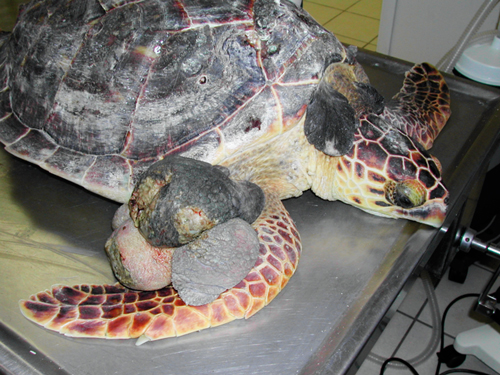Sea turtles have always been considered a sentinel animal in our world’s oceans—the canaries in the coal mine, if you will. These present-
Sea turtles have always been considered a sentinel animal in our world’s oceans—the canaries in the coal mine, if you will. These present-day dinosaurs have remained relatively unchanged since the beginning of time. There are many challenges to their existence from the moment they come into the world, and it is said that only one in 100 will survive from hatchling to adulthood.

Douglas Mader
Fibropapilloma is characterized by the proliferation of fibropapillomas (FP), cauliflower-like growths ranging in size from a few millimeters to greater than 15 centimeters. This green sea turtle has large fibropapillomas on its flipper.
In addition to natural predators such as sharks, the biggest threats to sea turtles come from humans, in the form of poaching, commercial fishing, recreational interactions and habitat destruction. On top of all of this are the effects of climate change and pollution on their immune systems, making them more susceptible to natural diseases.
Common to sea turtles in tropical waters worldwide is a proliferative disease known as fibropapilloma associated turtle herpesvirus (FPTHV). First described in 1938 in the green turtle (Chelonia mydas), the disease, which is caused by an alpha herpesvirus, is now found in all species of sea turtles except for the leatherback (Dermochelys coriacea). The prevalence of the devastating disease has been reported as anywhere from 0 to 90 percent, depending on the geographic location.
This debilitating disease is characterized by the proliferation of fibropapillomas (FP), cauliflower-like growths ranging in size from a few millimeters to greater than 15 centimeters. They can occur both on the outside of the animal (the skin and the eyes) and on the inside (lungs, liver, kidneys, intestines, etc.). The fibropapillomas themselves are benign, but en mass these lesions debilitate the animals, causing anemia, progressive immunosuppression and increased susceptibility to other disease.
When the FPs are on the outside, it is an easy diagnosis. Unfortunately, diagnosis can be difficult regarding internal lesions. At the Sea Turtle Hospital in Marathon, Fla., where over half of our patients are affected with FPTHV, all incoming turtles receive comprehensive physical examinations that include exterior evaluation, blood work, x-rays and endoscopy to evaluate the internal organs. Although most FP tumors are identified with these methods, some are still missed.
Magnetic resonance imaging (MRI) has been shown to be superior and more sensitive in identifying internal FPs, which are most commonly found in the lung tissue. The liver, gall bladder, intestinal tract (both mesentery and mural), kidneys and in the shell are other locations where FPs have been seen. If internal FPs exist the patient’s prognosis is grave and the animals are immediately euthanized and necropsied. Unfortunately, MRI technology is costly and not readily available to some of these affected animals.
Although, in the wild, some of these tumors will regress and the turtles will go on to live tumor free, the numbers of spontaneous regression cases appears to be low. When a FP-affected turtle is found every effort is made to try and remove the tumors. To date, it appears that the most effective method of controlling FPTHV is surgical removal of the masses. The CO2 laser has revolutionized the procedure. Minimal bleeding occurs when the laser is used, even in the larger lesions. Post-removal, the laser can be used to shrink and seal tumor sites so that no sutures are necessary. The patients are started on antibiotics and pain medications post-operatively and then held out of the water for 24 hours while they recover. Once clear of the effects from the anesthesia, they are allowed back into the water.
No formal studies have been conducted to determine the amount of time FP animals need to be monitored post mass removal before being released back to the wild. At the Sea Turtle Hospital, patients are kept for one year. If no regrowth occurs during that time the turtles are released. If FPs return, the procedure and the resulting time clock afterward starts over.
The reason that FPTHV has crossed sea turtle species and seems to have become more prevalent is not known; however, the belief is that human-induced environmental factors (ocean warming, algal blooms, pollution, etc.) may be co-factors.
Douglas R. MADER, MS, DVM, DABVP (C/F, R/A), DECZM (HERPETOLOGY), is a graduate of the University of California, Davis. He owns the Marathon Veterinary Hospital in the Conch Republic, and is a world-renowned lecturer, author and editor. He sits on the review boards of several scientific and veterinary journals.


